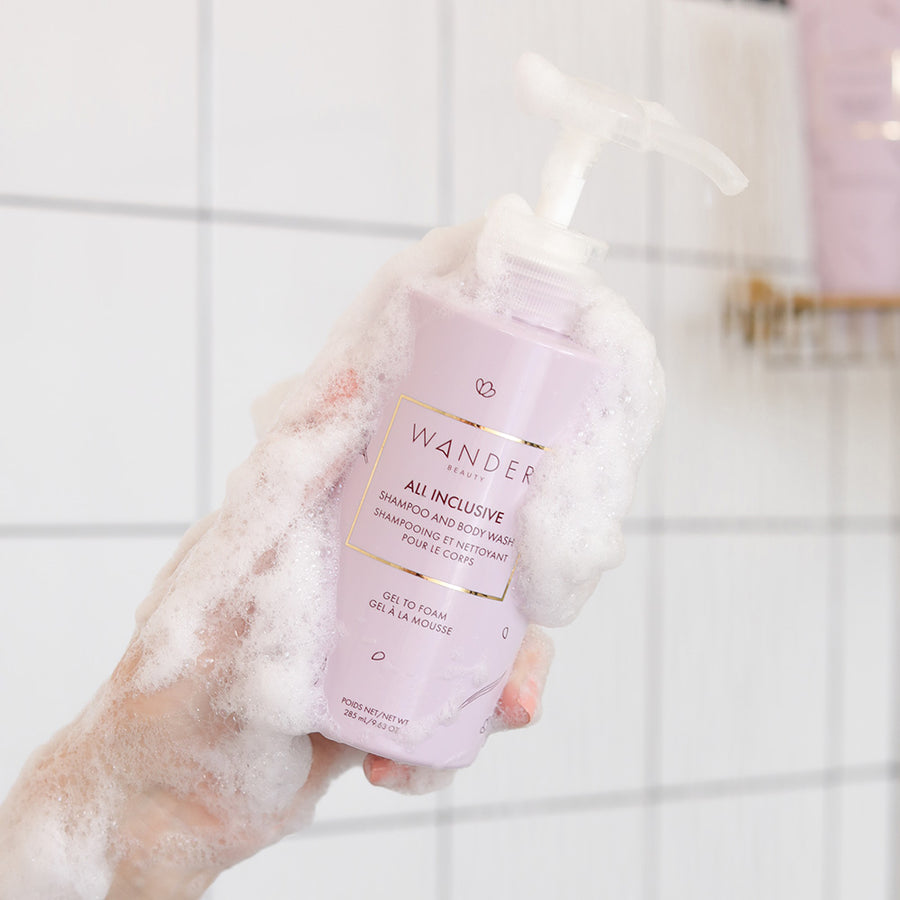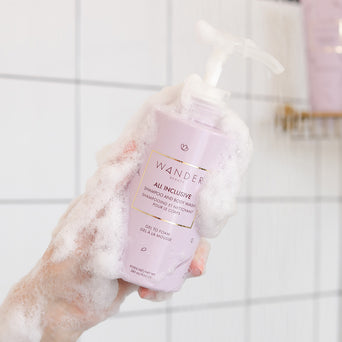The Best Way to Treat Dry Hair and Damaged Hair
By Wander Beauty | Sep 05, 2022
Unwanted frizz, split ends, and hair loss. Sound familiar? If so, you might be dealing with dry, damaged hair. From color treatments to too-frequent heat styling, there are a number of things you may be doing that dry out and damage your hair. Join us as we take a look at the most common causes of damage, signs of damage, and the best hair care tips to nourish your hair and prevent further damage.
Most common causes of hair damage
- Hair dye: Whether you just wanted to cover up a few gray hairs, reinvent your look, or try out a playful trend such as pastel or mermaid, dying your hair (especially at home) can have long-lasting consequences. Chemical dyes strip the hair of its natural moisture and alter the hair’s protein structure, making it coarse, thin, and weak.
- Bleaching: Bleach is used to dissolve the natural color from your hair, strand by strand, in order to lighten its appearance. The result is dry, porous, brittle, and fragile hair. Hair loses strength and becomes less elastic, making it more prone to breakage and frizz.
- Heat tools: Whether you're drying your hair after a shower, straightening it for a sleek, sophisticated look, or going for a classic curl, heat tools can “cook” hair fibers, leading to raised cuticles and porous hair – which ultimately results in damage-prone strands.
- Infrequent trims: Going too long between cuts can lead to split ends, which increases the likelihood of breakage and thinning.
Signs of hair damage
Tangling
Perhaps surprisingly, tangled hair is not just the result of brushing infrequently, but also a sign of damage. The hair shafts of healthy hair are strong and smooth, and the cuticles don’t knot easily. What does tangle is thin hair shafts and rough cuticles, with a lack of moisture adding to the potential for knots.
What to do
- Never brush hair when wet, as wet hair breaks easily and is prone to being overstretched. A wide-toothed comb can be used to work conditioner through hair, but hair should be completely dry before brushing it.
- When brushing, always start from the ends of the hair and slowly work out the knots as you move up towards the roots. Forceful tugging will cause breakage and frizz.
- Opt for a relaxed ponytail, loose bun, or braid when putting your hair up, as tension in hair ties can cause hair breakage and headaches. Again, avoid tying hair up when wet.
- If your hair is already damaged and you experience frequent tangling, a leave-in conditioner is a good hair treatment for damaged hair.
Dullness
Damaged hair may lack natural oils and hydration that coats the cuticle, resulting in a loss of shine and volume.
What to do
- Don't wash your hair every day. Overly frequent shampooing does not allow hair enough time to replenish its natural oils, resulting in dry, brittle strands. This will also cause the color to fade faster and will require the use of heat styling tools more often. Instead, try washing hair every three to four days or every other day if absolutely necessary.
- Be sure to use the best shampoo for dry, damaged hair – one that has been specially formulated for dry hair with ingredients for added moisture.
Frizz
Frizz isn't just annoying; it's a sign that your cuticle isn't lying flat and that the inner fibers of your hair are exposed.
What to do
- When possible, rinse with cold water. Hot water expands hair cuticles, stripping hair of its natural oils, whereas cold water helps the hair retain its hydrating nutrients and oils. Cold water also helps improve blood circulation and may help promote hair growth.
- Avoid shampoos and other hair products with harsh chemicals, and instead, opt for moisturizing products and natural ingredients, such as Bamboo Extract and Crambe Abyssinica Seed Oil.
Breakage
Dry, brittle hair can feel like straw (especially at the ends) and will be more prone to breaking and shedding. This often occurs in overly processed hair and may be a symptom of nutritional deficiency.
What to do
- Eat a well-balanced diet and be sure to include foods rich in biotin, vitamins A and C, and zinc, or supplement with these.
- Protect hair from the sun during the harshest hours of the day by wearing a hat or UV protection product.
Expert hair care tips
Wondering how to fix dry, damaged hair? Prevention is the best cure, and here are some helpful tips to care for your hair and prevent any further damage.
Opt for a low-maintenance look
Hair experts recommend choosing a dye within three shades of your natural color, as well as opting for darker shades rather than lighter ones to limit damage. Unnatural colors like pastels, pinks, and blues, as well as colors very different from your natural color, are both difficult to maintain and require more frequent touch-ups.
To limit damage, we recommend waiting between eight and 10 weeks (or longer) between dye jobs. It’s also best to avoid box dye and invest in professional services. A professional colorist will use the best products to minimize damage. Going for a more natural look, such as balayage, is low-maintenance and will limit the frequency of damaging dyes.
Bleach less often
Bleach is highly damaging to the hair, so it's best to either bleach less frequently or avoid it entirely. If you feel you absolutely must bleach your hair, be sure to hydrate your hair prior to your appointment and avoid heat styling for a couple of weeks. Protecting your hair from sun damage and avoiding chlorine pools is also important.
Use heat tools with caution
Be sure to air dry your hair whenever possible and use heat tools on the lowest possible setting – especially if you have dry or color-treated hair. Experts recommend using heat styling tools no more than once a week and using heat protection products when doing so. It's best to use hair masks for dry, damaged hair at least once a week. Our Scenic Route Hair Treatment can be used as a deep conditioner, hair mask, or leave-in treatment. It contains coconut oil, which hydrates the hair from the inside out, as well as antioxidant-rich bilberry fruit extract and grapeseed oil, which acts as a natural sealant.<product>1</product>
Trim your hair regularly
A good hair care routine includes regular trims. This removes dry, damaged ends and helps prevent further damage. Experts recommend getting your hair trimmed every four to six weeks, though you should talk to your hairdresser to determine what's best for you. Using high-quality products that don't contain aggressive ingredients, such as synthetic fragrances and parabens, and doing regular hair masks or treatments will help keep your hair in good condition between trims.
Discover the best hair repair treatment for damaged hair from Wander Beauty
Wander Beauty’s hair and skincare products have been specially formulated with your health in mind. We don't use any parabens, phthalates, sodium lauryl sulfate (SLS), sodium laureth sulfate (SLES), mineral oils, or synthetic fragrances. Discover effortless everyday essentials from Wander Beauty.
The Best Way to Treat Dry Hair and Damaged Hair

Unwanted frizz, split ends, and hair loss. Sound familiar? If so, you might be dealing with dry, damaged hair. From color treatments to too-frequent heat styling, there are a number of things you may be doing that dry out and damage your hair. Join us as we take a look at the most common causes of damage, signs of damage, and the best hair care tips to nourish your hair and prevent further damage.
Most common causes of hair damage
- Hair dye: Whether you just wanted to cover up a few gray hairs, reinvent your look, or try out a playful trend such as pastel or mermaid, dying your hair (especially at home) can have long-lasting consequences. Chemical dyes strip the hair of its natural moisture and alter the hair’s protein structure, making it coarse, thin, and weak.
- Bleaching: Bleach is used to dissolve the natural color from your hair, strand by strand, in order to lighten its appearance. The result is dry, porous, brittle, and fragile hair. Hair loses strength and becomes less elastic, making it more prone to breakage and frizz.
- Heat tools: Whether you're drying your hair after a shower, straightening it for a sleek, sophisticated look, or going for a classic curl, heat tools can “cook” hair fibers, leading to raised cuticles and porous hair – which ultimately results in damage-prone strands.
- Infrequent trims: Going too long between cuts can lead to split ends, which increases the likelihood of breakage and thinning.
Signs of hair damage
Tangling
Perhaps surprisingly, tangled hair is not just the result of brushing infrequently, but also a sign of damage. The hair shafts of healthy hair are strong and smooth, and the cuticles don’t knot easily. What does tangle is thin hair shafts and rough cuticles, with a lack of moisture adding to the potential for knots.
What to do
- Never brush hair when wet, as wet hair breaks easily and is prone to being overstretched. A wide-toothed comb can be used to work conditioner through hair, but hair should be completely dry before brushing it.
- When brushing, always start from the ends of the hair and slowly work out the knots as you move up towards the roots. Forceful tugging will cause breakage and frizz.
- Opt for a relaxed ponytail, loose bun, or braid when putting your hair up, as tension in hair ties can cause hair breakage and headaches. Again, avoid tying hair up when wet.
- If your hair is already damaged and you experience frequent tangling, a leave-in conditioner is a good hair treatment for damaged hair.
Dullness
Damaged hair may lack natural oils and hydration that coats the cuticle, resulting in a loss of shine and volume.
What to do
- Don't wash your hair every day. Overly frequent shampooing does not allow hair enough time to replenish its natural oils, resulting in dry, brittle strands. This will also cause the color to fade faster and will require the use of heat styling tools more often. Instead, try washing hair every three to four days or every other day if absolutely necessary.
- Be sure to use the best shampoo for dry, damaged hair – one that has been specially formulated for dry hair with ingredients for added moisture.
Frizz
Frizz isn't just annoying; it's a sign that your cuticle isn't lying flat and that the inner fibers of your hair are exposed.
What to do
- When possible, rinse with cold water. Hot water expands hair cuticles, stripping hair of its natural oils, whereas cold water helps the hair retain its hydrating nutrients and oils. Cold water also helps improve blood circulation and may help promote hair growth.
- Avoid shampoos and other hair products with harsh chemicals, and instead, opt for moisturizing products and natural ingredients, such as Bamboo Extract and Crambe Abyssinica Seed Oil.
Breakage
Dry, brittle hair can feel like straw (especially at the ends) and will be more prone to breaking and shedding. This often occurs in overly processed hair and may be a symptom of nutritional deficiency.
What to do
- Eat a well-balanced diet and be sure to include foods rich in biotin, vitamins A and C, and zinc, or supplement with these.
- Protect hair from the sun during the harshest hours of the day by wearing a hat or UV protection product.
Expert hair care tips
Wondering how to fix dry, damaged hair? Prevention is the best cure, and here are some helpful tips to care for your hair and prevent any further damage.
Opt for a low-maintenance look
Hair experts recommend choosing a dye within three shades of your natural color, as well as opting for darker shades rather than lighter ones to limit damage. Unnatural colors like pastels, pinks, and blues, as well as colors very different from your natural color, are both difficult to maintain and require more frequent touch-ups.
To limit damage, we recommend waiting between eight and 10 weeks (or longer) between dye jobs. It’s also best to avoid box dye and invest in professional services. A professional colorist will use the best products to minimize damage. Going for a more natural look, such as balayage, is low-maintenance and will limit the frequency of damaging dyes.
Bleach less often
Bleach is highly damaging to the hair, so it's best to either bleach less frequently or avoid it entirely. If you feel you absolutely must bleach your hair, be sure to hydrate your hair prior to your appointment and avoid heat styling for a couple of weeks. Protecting your hair from sun damage and avoiding chlorine pools is also important.
Use heat tools with caution
Be sure to air dry your hair whenever possible and use heat tools on the lowest possible setting – especially if you have dry or color-treated hair. Experts recommend using heat styling tools no more than once a week and using heat protection products when doing so. It's best to use hair masks for dry, damaged hair at least once a week. Our Scenic Route Hair Treatment can be used as a deep conditioner, hair mask, or leave-in treatment. It contains coconut oil, which hydrates the hair from the inside out, as well as antioxidant-rich bilberry fruit extract and grapeseed oil, which acts as a natural sealant.<product>1</product>
Trim your hair regularly
A good hair care routine includes regular trims. This removes dry, damaged ends and helps prevent further damage. Experts recommend getting your hair trimmed every four to six weeks, though you should talk to your hairdresser to determine what's best for you. Using high-quality products that don't contain aggressive ingredients, such as synthetic fragrances and parabens, and doing regular hair masks or treatments will help keep your hair in good condition between trims.
Discover the best hair repair treatment for damaged hair from Wander Beauty
Wander Beauty’s hair and skincare products have been specially formulated with your health in mind. We don't use any parabens, phthalates, sodium lauryl sulfate (SLS), sodium laureth sulfate (SLES), mineral oils, or synthetic fragrances. Discover effortless everyday essentials from Wander Beauty.



